When ballet dancer David Hallberg was at the height of his fame, he vanished from the public eye.
The star of the American Ballet Theatre – and the first US citizen to be invited into the top ranks of Russia’s renowned Bolshoi – had fled to Australia.
“I was broken,” he says of that time in 2015. Two surgeries had not fixed a devastating foot injury. He couldn’t dance.
So in a last-ditch attempt at recovery, Hallberg boarded a plane for Melbourne to visit the Australian Ballet’s little-known “artistic health” centre, where a team of physiotherapists and La Trobe University researchers had been quietly pioneering breakthroughs in sports medicine.
The centre is run by physiotherapist Dr Sue Mayes, who Hallberg had seen at work while touring Japan. She had treated his colleagues using methods that seemed at odds with the old recovery wisdom of the ballet world, that is to rest, stretch – and don’t complain.
“It was daunting when we saw the state he was in,” Mayes says.
It took more than a year of intensive physiotherapy, but Hallberg returned to the stage. “I bought a one-way ticket, and they brought me back to life,” he says.
La Trobe researcher and physio Dr Ebonie Rio oversees dancer Laura Griffiths in calf raises.Credit: Eddie Jim
When the chance came to lead the Australian Ballet as artistic director, Hallberg boarded a plane again in 2021.
Today he calls the ballet’s health centre the “beating heart” of the company. Here, researchers are learning not only how to keep dancers dancing – they haven’t lost one to injury in more than a decade – they’re also exploring the limits of the human body.
Inside this warren of high-tech treatment rooms and studios, dancers spin with wearable devices tracking their movements or hop onto machines to test the strength of their calves.
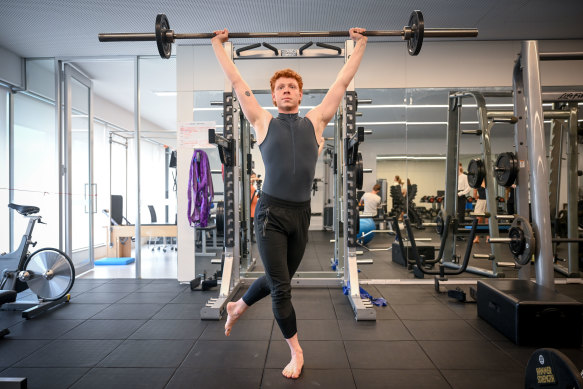
Australian Ballet dancer Jacob de Groot lifts weights at the company’s health centre in October.Credit: Eddie Jim
“When I started 28 years ago, it was just me and a massage therapist in a little room,” Mayes says. Injuries would routinely end dance careers. “And they’d all retire in their 30s. Today they’re dancing well into their 40s.”
The Australian Ballet is one of the busiest dancing companies in the world, performing hundreds of shows a year, including a free program it runs in schools. “Most ballets have twice as many dancers but perform half as much, and they don’t tour,” says Dr Ebonie Rio, a senior La Trobe researcher and physio based at the ballet.
An intimidating array of heavy weights line the walls of the gym. The male dancers have been running a “partnering circuit” using heavy water bags and barbells in the place of their female partners to practice lifting – and catching. One exercise is called “bad romance”.
“The men obviously have to be strong to lift,” says Mayes as dancer Jacob De Groot hefts a barbell above his head, his toes still pointed. “But the women train just as hard. People don’t realise they’re elite athletes as well as artists.”
So rigorous is the training and physiotherapy on offer at the Australian Ballet that other athletes from codes around the country will often drop in, including AFL stars.
Mason Wood from the St Kilda Football Club was constantly in shin splints before he met Mayes.
“And I had this basically dead toe hanging to the side,” Wood says, while stretching his foot at the bar against a heavy-duty resistance band.
“Three weeks later, the splints were off, I was out of orthopedics, and my top speed jumped.”
Rio says studying elite dancers and athletes pushing their bodies to the limit will help the wider population too, from young kids starting sport to the elderly.
During 2023’s exacting season of Swan Lake, a famously fast and difficult ballet, La Trobe tracked the dancers, measuring the health of their Achilles tendons using special ultrasounds, checking ankle movements, and even scoring how many perfect calf raises could be done.
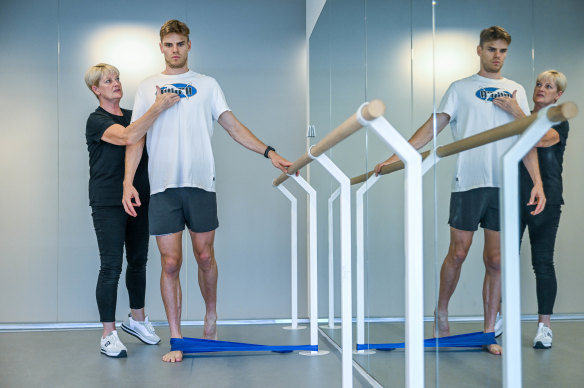
Australian ballet physio Sue Mayes with St Kilda footballer Mason Wood. Credit: Joe Armao
“Thirty seems to be the magic number to strengthen and protect against injury,” says Rio, of calf raises. “We do 35 to be safe.”
“AFL players saw what we were doing and have started this too.”
“Footballers break down in all sorts of ways,” says Wood, who studied a bachelor’s degree in sports science under Mayes. “But the ballet [dancers] are so precise, they’re good at isolating the problem areas.”
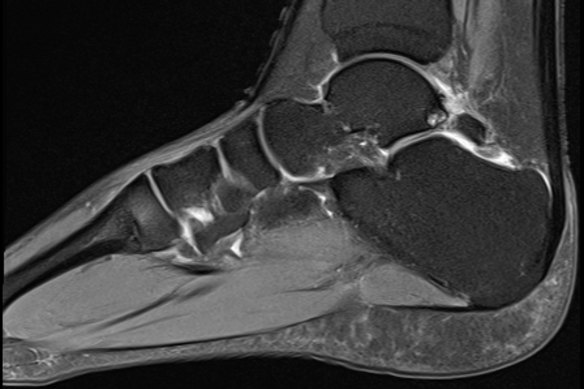
An MRI scan of a ballet dancer’s ankle.
He admits he is envious of the dancers’ “calf bulk”.
“I sat in on a few classes,” he says. “Those jumps they do, it’d be amazing to replicate that on the footy field, but it’s beyond me.”
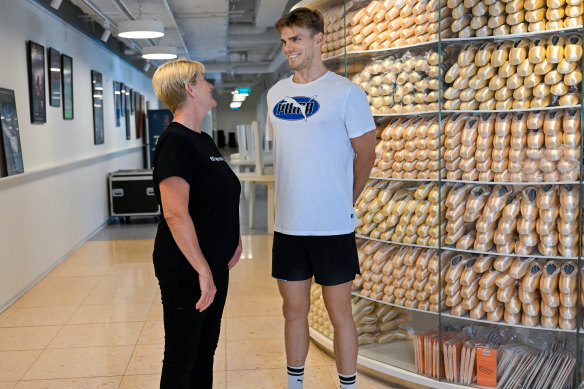
Wood studied sports science with Mayes as part of her research based at the ballet with La Trobe University.Credit: Joe Armao
AFL players will usually suffer more sudden traumatic injuries than dancers, Mayes says, who studied dance herself in her youth. “A torn Achilles or ACL is feared in footy but rare in dancers, though it does happen. We’ve had a spate of unusual injuries post-COVID. But they’re back dancing now. There are few injuries that I haven’t seen.”
At the height of his fame, when Hallberg heard the pop of his ankle beneath him, Mayes says it was the final straw for an injury that had long been building.
“And he had so much fear,” she recalls. “He’d been shown MRIs with a big hole in his Achilles, told he’d never dance again. He couldn’t even plié. So it took a lot to convince him he could move.”
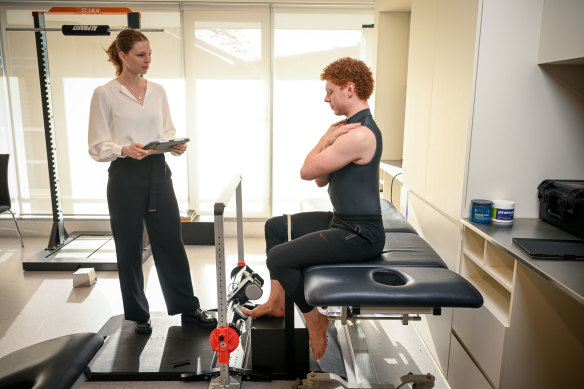
Brazilian PhD student Bruna Tessarin tests the calf strength of dancer Jacob De Groot.Credit: Eddie Jim
Rest is a common myth in recovery, she says. “We were getting him running up and down stairs.” About 14 months later, he was dancing again.
“And he still had that hole in his Achilles,” says Mayes. “He’ll have it forever.”
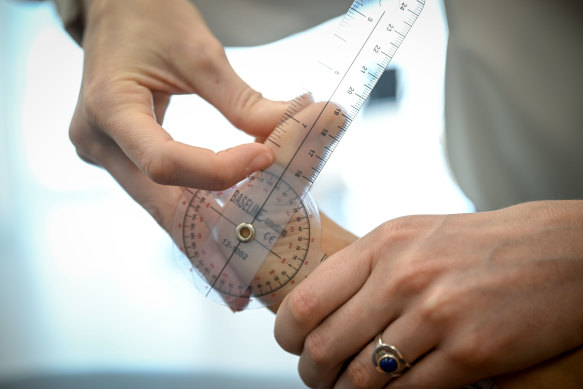
Physiotherapists even measure the bend in dancers’ toes.Credit: Eddie Jim
One of the Australian Ballet’s newest arrivals, Laura Griffiths, grew up in regional Victoria and trained at the English National Ballet School in London. She says the company’s exercise regimen was overwhelming at first. “But I can feel myself getting stronger,” she says.
When Griffiths fractured her foot last year in the UK just ahead of her debut audition season, she felt the same dread Hallberg described. “You train for 14 years from a kid, and then it can all go wrong,” she says. “It was really hard.”
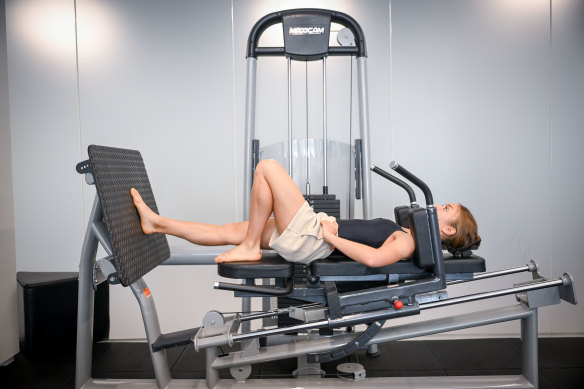
Dancer Laura Griffiths in the Australian Ballet gym.Credit: Eddie Jim
Slowing down to the very basics of dance, from the precise angle of a pointed toe to the rise of her heel, was hard too. “But it made me a better dancer,” she says.
Hallberg agrees that the resilience the health centre builds in his dancers means they can lean into style – and push themselves to new artistic heights.
“This is the support I never had,” Hallberg says. “All the big ballet companies around the world are looking at what we do now. The secret is finally out.”
Videography by Nicole Precel, video editing by Margaret Gordon.
Get the day’s breaking news, entertainment ideas and a long read to enjoy. Sign up to receive our Evening Edition newsletter.


